Travel Guides - St. Petersburg, Russia's Capital - 1904 American Article
Bay View Magazine - October 1904 - Augustus I. C. Hare
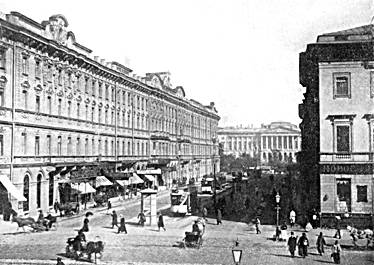 THE journey from the frontier station of Wicrzbolow to the Russian capital is wearisome and uninteresting, and the distance of five hundred and sixty miles over bare, monotonous, characterless plains is usually traversed by night, as far as possible, for there is nothing in the land-scape to rest or please the eye of the traveler. Night closes in upon a weird scene of jagged pines rising from a desolate heath against a lurid crimson sky. Low fir-woods and open corn-fields greet the eye at dawn, and we watch for the joyful moment of excitement when two vast domes appear beyond the hitherto feature-less waste, one purple and the other with a brilliant gleam of gold upon its surface, - the dome of the Church of St. Alexander Nevsky and of St. Isaac's Cathedral in the Russian capital.
THE journey from the frontier station of Wicrzbolow to the Russian capital is wearisome and uninteresting, and the distance of five hundred and sixty miles over bare, monotonous, characterless plains is usually traversed by night, as far as possible, for there is nothing in the land-scape to rest or please the eye of the traveler. Night closes in upon a weird scene of jagged pines rising from a desolate heath against a lurid crimson sky. Low fir-woods and open corn-fields greet the eye at dawn, and we watch for the joyful moment of excitement when two vast domes appear beyond the hitherto feature-less waste, one purple and the other with a brilliant gleam of gold upon its surface, - the dome of the Church of St. Alexander Nevsky and of St. Isaac's Cathedral in the Russian capital. St. Petersburg is a populous city whose inhabitants number more than one and a half million. It covers forty-two square miles on the banks of the Neva and on the islands formed by the different branches of this river. The city is young in age and Western in architecture; it lacks the picturesque quaintness and distinctively Byzantine atmosphere of Moscow, but it affords a fine opportunity to study the wonderful national development of the "land of the Tsars" - one of the most instructive examples of national development of which we have any record in history. A number of marshy islands near the mouth of the river Neva were, at the beginning of the last century, primarily inhabited by wolves and bears, though a few fishermen's huts rose here and there amid the thickets oil the drier parts of the morass. Ivan the Terrible had some idea of founding a town here, but it was left for Peter the Great to begin the work in 1703, founding St. Petersburg "for a window by which the Russians might look out into civilized Europe." Till the time of Peter, who is often said to have knouted Russia into civilization, the country had been more Asiatic than European. It was Peter the Great, the first tsar of Russia who had seen the sea, who realized that the future commerce of the country must depend on the creation of a naval force with which to occupy the Baltic. The site of the fortress which he built with this intention was selected as near as possible to the frontier of Sweden, because at that time the Swedes were the most formidable enemies of Russia It was also chosen with a view of withdrawing the Russian nobles from their magnificent somnolence at Moscow, and of gradually civilizing them by rubbing them against men of more polished manners and tastes.
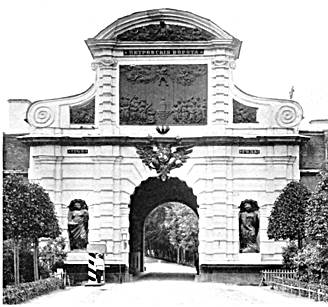 Right: Entrance to the Fortress of St. Petersburg.
Right: Entrance to the Fortress of St. Petersburg.
In the beautiful and shady enclosure of the fortress, on the north bank of the Neva, are the cathedral of Sts. Peter and Paul, the original cottage of Peter the Great, and the fortress. All are sights that awaken a thrill of interest. The cathedral is Russia's Westminster Abbey. Within and ranged from either side of the altar are the plain marble tombs of all the mighty Romanoffs, emperors, tsars, and queens, from Peter the Great to Alexander III. Usage in the Russo-Greek Church forbids any sculptural figures over the tombs, and accordingly the memorials are chaste in their simplicity. Over the pall of the beloved Alexander II is the simple inscription, "his Imperial Majesty Alexander II." Peter the Great's house is now enclosed in another for better preservation. The fortress is no longer a purpose of defense, the fortifications of Cronstadt - at the mouth of the Neva serving that purpose.
Peter - or Piter, as he wrote the name called his new city St. Petersburg in honor of his patron saint. The common people often call it simply Piter, and poets and others write of it thus. To the founder of the city, it was the apple of his eye, his Paradise, as he calls it in one of his letters. He regarded neither the danger of floods by which parts of the city are constantly inundated. nor the unhealthfulness by which the death-rate is still much higher at St. Petersburg than in any other city of Europe. When Catherine II complained of the ill effects of the climate upon her health, one of her courtiers justly replied:
"It is not the fault of God, Madam if men insist upon building the capital of a great empire upon land destined by Nature for the abode of bears and wolves."
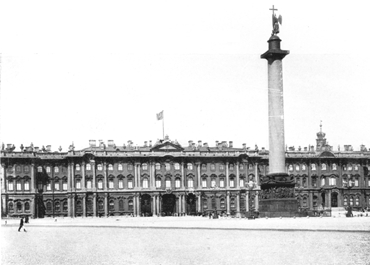
Above: A Part of the Winter Palace, Alexander Square
Here visiting royalty is always entertained and here take place the splendid receptions and balls by the imperial family. So large is the ball room that it will accommodate three thousand dancers time and two thousand in the banqueting room. One of the rooms which Americans always visit reverent feelings is the apartment of Alexander 11, the liberator of the serfs. It is still piously preserved as it was oil the day that the Tsar fell by the assassin's hand, and it was there that he died.
It was upon the most inland of the islands at the mouth of the Neva that Peter laid his foundations. He personally superintended the building of one of the bastions of his fortress, and gave the others in charge to his chief officers. At first the fortifications were built of wood, but three years afterward they were re-erected in stone. The first fortress was begun on May 16, 1703, and finished in five months. Wheel-barrows were then unknown, and workmen scraped up the earth with their hands, and carried it to the ramparts in bags made of matting. Within the fortress a little church was erected and dedicated to St. Peter and St. Paul In 1711 Peter constructed for himself just outside the fortress a little brick cottage which he called his palace; this cottage still stands as a monument to the great sovereign. Tsar Peter decreed that all the nobility and the principal merchants should have homes in the new city, while every large vessel on the Neva was compelled to bring thirty stones, every small one ten, and every peasant's cart three, toward the building of the capital. Even breaking through the tradition - which required that imperial princes should be buried at St. Michael of the Kremlin of Moscow, Peter marked out his own tomb and those of his successors in his new cathedral. The very idea of deserting Moscow,the mother of a thousand churches and cathedrals, and of establishing another metropolis far away upon the banks of the Neva, was repugnant to the feelings of priest and people. But no opposition of priest or party ever interfered with the projects of this strong man armed, and in spite of tears, protestations, and much perturbation of the national spirit, the transference of the seat of government from Moscow to St. Petersburg became in 1710 an accomplished fact. The mushroom growth of the city caused the buildings of Peter the Great's time to be of the most ephemeral character, so that scarcely anything we now see dates further back than the reign of Catherine II, and though the size of the city has now surpassed the utmost hope of its founder, it is still only an immense outline which it will require future empresses and almost future ages to complete.
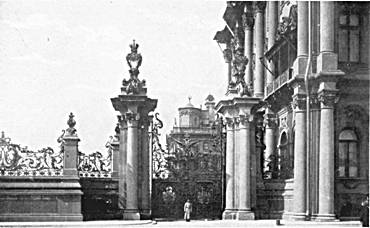 Left: A Nearer View of the Winter Palace.
Left: A Nearer View of the Winter Palace.
The best hotels in St. Petersburg, though sufficiently comfortable, would be considered very second-rate in any other capital, and the food they supply very indifferent. The rooms are clean and are all fitted with the double windows which are here an absolute necessity. They are hermetically scaled in winter, with only a single pane of the inner window being made to open. We were at the Hotel de France in the Grand Morskaia, a broad street ending close to the hotel in a huge archway of an aimless architectural character thoroughly characteristic of St. Petersburg. Passing under the archway, we emerged at once into a vast open space, the center of which is occupied by th granite Alexander Column, said to be the greatest monolith of modern times. It is the work of a Frenchman, and rests on a pedestal bearing the simple inscription: "To Alexander I. Grateful Russia." The monolith is eighty feet high, but the crowning figure with its pedestal gives an added height of seventy feet. To the left are the Isaac Cathedral and the graceful tower and spire of the Admiralty Building. Opposite is the huge Winter Palace, which with the exception of the Vatican and the Versailles, is the largest palace in the world intended for residence; and though displaying no architectural taste, it has a certain grandeur from its immensity.
Like all Russian palaces, the Winter Palace is a mixture of splendor and shabbiness, luxury and discomfort. In going over it, visitors see everything gorgeously adapted for state ceremonials, but wonder how and where the imperial family can live. The enormous structure has no suggestion of the comfort and cheer of a home. This palace, from whose gateway Catherine II emerged on horseback, crowned with an oak wreath and with a drawn sword in her hand to ut herself at the head of her army, is full of associations with the modern history of the country. The balls and banquets at the Winter Palace are celebrated for their magnificence, especially the fetes of the first of January, and have always been worthy of the ruler of so vast an empire. The whole of the splendid interior was consumed by fire in 1837, but was speedily restored. The so-called Ambassador's Stairs, by which the members of the royal family ascend on ceremonial occasions to the State apartments, are of white Carrara marble and surpassingly beautiful. This staircase, St. George's Hall, with its' white-marble Corinthian columns, and the throne room of Peter the Great, are the greatest features of the palace. it numbers among its treasures many priceless historical paintings and the portraits of various generals.
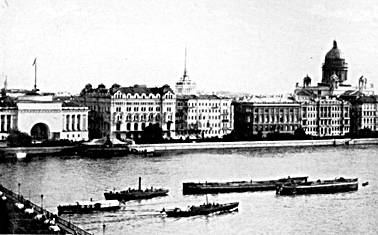
Above: The Neva Quay of St. Petersburg.
On the farther side of the Winter Palace flows the great river Neva, to which St. Petersburg is indebted for food, clothing, water, and building materials. The commerce on this river supplies all the needs of the vast, isolated city. On the south side it is lined with palaces, built chiefly of brick, but occasionally of Finland granite. The quays are the pleasantest walk in the town, and are delightful in the fresh clearness of the northern morning. Beyond the river stretch the warehouses of Basil Island, the largest of the islands at the mouth of the Neva, and the mercantile quarter of the city. the Academy of Sciences, the Academy of Arts, and the School of Marine Cadets vary the line of buildings along the quay of Basil Island.
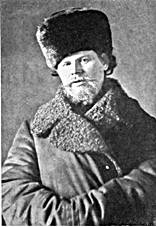 Left: A Russian Merchant in a winter suit.
Left: A Russian Merchant in a winter suit.
Any strangers taking their first walk in St. Petersburg will be attracted by the pretty and quaint spire of the Admiralty, to the left of the Winter Palace. This spire and that of the citadel are covered with the gold of the ducats of Holland offered by the Dutch Republic to Peter the Great. In the center of the garden, beyond the Admiralty, stands the famous statue of Peter the Great. It was executed by the Frenchman, Falconet, and represents the great tsar in the most impossible of positions: reining in his horse upon the very edge of a precipice, stretching out his hand toward the Neva, and trampling on the enormous serpent of Conspiracy. The pedastal bears the simple inscription, "To Peter the First, Catherine the Second." Upon the garden which contains this statue, the Cathedral of St. Isaac looks down; in spite of its many defects it is the queen of St. Petersburg churches. It is founded upon piles, and owing to the fact that they have never been properly secured, constant repairs and rebuilding have been necessary; the original foundation cost nearly a million of roubles, The first edifice was of wood, and it was rebuilt in stone; then it was nobly begun again in marble by Catherine II and unworthily finished in brick by Paul I, whence the epigram, "This church is the symbol of three reigns, granite, pride, and destruction." The present church was begun afresh in 1819 and finished in 1858, but it is already threatened with dissolution by the sinking of its foundations. It is dedicated to St. Isaac of Dalmatia, on whose festival Peter the Great was born. Its one hundred pillars are glorious granite monoliths from Finland, buried there for centuries amid the swamps. its most striking feature, as is that of every Russian church, is the golden screen, or iconastos, shutting off the inner sanctuary, where the Greek priest is far more. withdrawn from the congregation than the Latin priest standing before the altar. In this cathedral the screen is decorated with huge columns of malachite, which are greatly admired by the Russians, though they have the effect of green paint. The lapis lazuli columns at the portal are very beautiful, Upon the iconastos of a Russian church always hang the sacred icons, or pictures, in regular order. In the place of honor on the south side of the screen is the figure of the Redeerner. On the north side is the Madonna, whom the Greek church holds in intense veneration, without allotting her any precise part in the scheme of salvation or protection of the church. Next to the Savior is always placed the saint to whom the church is dedicated; the position of the other pictures may be changed. As all Russian churches stand due east and west, with the altar at the east, the screen and the icons have always the same relative position. The icons, or images, are covered with gilt with gilt metal, which is often encrusted with jewels, except the face and hands.
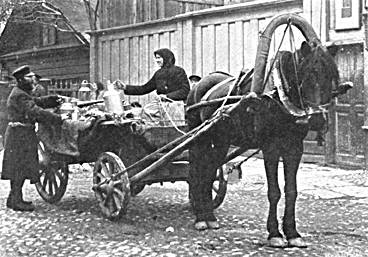 Right: Delivering Milk in St. Petersburg.
Right: Delivering Milk in St. Petersburg.
Two hundred steps lead from a door in the side of the portico to the roof of St. Isaac's church, whence there is a lovely view over the, city, with its domes and minarets. The great bell of St. Isaac's is the finest in this city of fine bells. It weighs over fifty-three thousand pounds and is ornamented with reliefs of the patron Saint and the five imperial builders of the cathedral. A passage inside the granite pillars of the cupola and a narrow staircase lead to the summit. Nowhere are the ramifications of the city better seen than from this point. We can look out over the forty islands in the delta of the Neva, many still swampy, uninhabited and scarcely known by name even in St. Petersburg. To the north stretches the most important part of the town, the "Great Side" - a thickly built mass of houses, divided in semi-circular form by the Moika Catherine, and Fontanka canals. These sections are subdivided by three principal streets - the Nevsky Prospekt, Peas Street, and the Resurrection Prospekt. The direction of these streets and of the canals determines that of the other streets. To the west, beyond the broad Neva, is Basil Island, the commercial town of Peter the Great, containing the Exchange, the Academy of Sciences, and the University. To the north is the Petersburg Side, the oldest part of the town, containing the Citadel, which commands only the town itself, and would be useless as a means of defence from a foreign enemy; and to the east is the Viborg Side, full of barracks and factories. Scattered over the town we see the siashes, or watch-towers for the police, whence they give notice of danger from its two enemies-fire and water-announcing water by red flags, and fire by balls of black leather in the daytime and by red lights at night.
The second walk which strangers will take in St. Petersburg will be undoubtedly along the Nevsky Prospekt, one of the finest streets in the world, where the street life of the city will be better seen than anywhere else. It is more than a hundred feet wide and extends for a distance of three miles, almost in a straight line, through all the rings of the town, - the aristocratic and commercial quarters, and the suburbs of the poor. As we walk along this main thoroughfare, we are struck by the number of men and boys among the pedestrians - girls are seldom seen on the streets of Russia, women never, unless they have something to do. In the end of the street nearest to the Admiralty smart sledges may be mett at every step during the season, but there are few aristocratic equipages in the summer when all the nobility are away in the country.
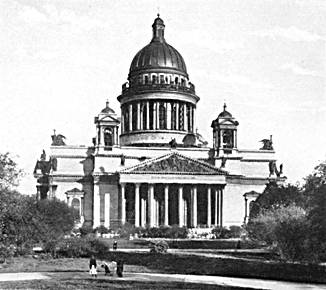
St. Issac's cathedral
The huge placards and colossal letters by which the tradesmen of London and Paris seek to attract public attention, are unknown in St. Petersburg. The reading public there is very limited; owing to the rigorous climate and the excessive dues of the customs house there are no plate-glass windows; therefore, the merchant resorts to pictorial illustrations of his wares. Huge pictures may be seen with appalling likenesses of fiddles, flutes, tarts, sugar-plums, sausages, coats, caps, shoes, stockings, etc. These signs that speak the only language intelligible to a Russian multitude, relieve in some measure the monotony of the streets.
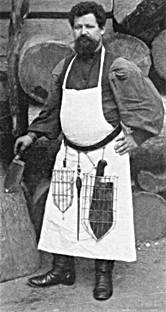 Left: A Typical Russian Butcher.
Left: A Typical Russian Butcher.
After crossing the Moika Canal, a semi-circle of columns oil the right (a ludicrous caricature of the colonnade of St. Peter's at Rome) announces the Cathedral of Our Lady of Kazan, the second church in the city, truly comical in its ambitious imitation. The building is chiefly remarkable as a pantheon and a museum of national trophies-keys of German and French towns, batons of French marshalls standards of French, Turkish, and Persian armies. Hither all emperors and empresses of Russia have been wont to come before setting out upon or returning from a journey, to invoke or thank "Our Lady of Kazan," - a holy picture which has its own annual fete-days.
We now reach the Stranger's Court, a labyrinth of narrow alleys, in which more than ten thousand merchants are at work. Furs are the chief article of national trade, but the icon and church-ornament shops are very curious, and the incense shops very pleasant. The handsome square which we next pass contains a fine statue of Catherine II, and is the site of the Alexander Theater and the Imperial Public Library. In vast St. Petersburg, built in speculation on a very distant future, every visit is an excursion. Endless are the open spaces; unfinished, infamously paved, edged by sheds, fringed with grass, almost populationless. It is a city of sumptuous distances, but all the streets are alike; there is no elegance and no originality. The brightest side of St. Petersburg is to be seen in the drive to the islands,-the favorite drive. First we pass along the stone quays of the Neva, the handsomest feature in this city of stucco and plaster, and observe that there is only one permanent stone bridge, for the new capital was purposely built without bridges, that Peter and his people might be constantly on the water, passing and repassing in the two-oared ferry-boats which were designed by the Tsar. and which are still in use. Many of the houses which line the quays are of great size, which may be imagined from the fact that in some of the palaces of the nobles, one hundred and twenty servants are not thought superfluous. It is not only the houses of the nobilitv which are gigantic in size-, there are many of these dwellings on the different floors of which every class and subdivision of society has its representatives. In one place there are three houses side by side, to pass which on foot will take a man a good half hour.
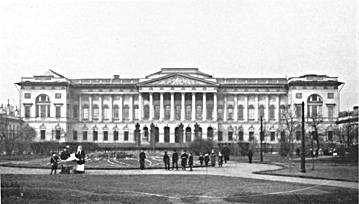
Above: Museum of Alexander III.
We cross the bridge to Basil Isle on the extreme eastern point of which is the Exchange. From there we cross to the five northwestern islands of the Neva which represent the country and are the parks of St. Petersburg. An endless variety of drives wind through shady alleys in primeval woods, and cross green meadows and rushing brooks, or skirt transparent lakes or broad reaches of the Neva. Interspersed among the trees are the pleasant Dachas, - villas originating in the gifts made by Catherine II to her favorites, that they might lay out gardens. Karnmenoi Ostrof, Stone Island, the chief residence of the wealthier classes, presents every type of viIla in many different forms of architecture,-Gothic, Italian Saracenic.
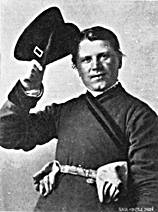 Left: A Russian Coachman.
Left: A Russian Coachman.
Many mornings in St. Petersburg may be pleasantly spent at the Hermitage, which is now the great art gallery of the city. Situated just beyond the Winter Palace, this is, externally, one of the handsomest buildings in the capital. The Hermitage was not a retreat, but a magnificent palace, the original hermit being the Empress Catherine II. On the ground floor of the palace is the famous collection of Scythian antiquities form the south of Russia, especially from the Crimea; it includes two incomparable vases. In the upper galleries are the paintings for which the Hermitage is renowned. There is an immense collection of the works of Teniers and other Dutch masters, with most valuable specinens of the Italian and Spanish schools. On a screen in the Rafael room are the two most celebrated miniatures in the world. One long gallery is devoted to memorials of Peter the Great, - his curious wooden chariot, his turning-lathes and telescopes, and other mementoes of this remarkable sovereign.
The same impression probably is left on the minds of all who have visited St. Petersburg, - a sense of the vastness of everything, the squares, the palaces, the overgrown, desolate streets; and in spite of much that is curious and strange, the tourist wearies of a city that is so lacking in beauty, so uncouth, and so irksome in the bondage of its petty restraints. Herbert Pierce in writing of Russia says:
"It is common to speak of St. Petersburg as a cosmopolitan city presenting nothing Russian in its appearance; like, in fact, to any other European city. This is hardly correct. Cosmopolitan it is, truly, but it resembles in no particular the typical European capital. Were it not for the ubiquitous peasant dress, there would still remain the great markets, the domed and minareted churches of Byzantine architecture, the wide wooden-paved streets frequently crossing the many canals and arms of the Neva, which all give to the Russian capital an individuality quite its own, although it is not built after the typical plan with a Kremlin. Moscow, the ancient capital, is indeed more distinctively Russian, and life there is more distinctively national. It is the center of the business life of Russia, but St. Petersburg must ever represent the thought and progress of the empire."
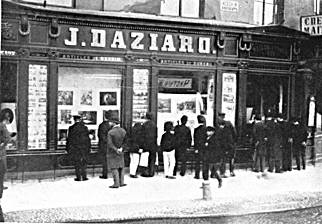
Above: The Streets of St. Petersburg.
The modern capital of Russia is a great educational center, attracting young people from all parts of the empire. Its scientific societies have a world-wide renown, especially the Royal Geographical and Historical Society, the Academy of Sciences, and the Archaelogical Society. The number of scientific, literary, artistic, and musical organizations grows constantly. It has a fine conservatory of music founded by Rubinstein. Although St. Petersburg is second only to Moscow in its manufacturing interests, and on account of its being the greatest port of Russia possesses commercial prestige, yet it is chiefly known as the intellectual center of the empire. It has been more influenced by European civilization than any other city of Russia, and its educated classes have always been the leaders in intellectual and scientific progress.
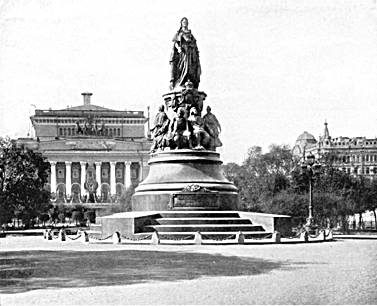
Above: Monument of Catherine the Great.
This is one of the squares of the Nevsky Prospekt. Back of the monument and to the left is the Alexander Theater; to the right is the Imperial Public Library. Preserved in the latter is the library of Voltaire, purchased by Catherine. This is to-day one of the great libraries of the world, numbering its books by over a million, with nearly forty thousand manuscripts. Here is preserved the priceless Codex Sinaiticus a complete copy of the Bible, written in the fourth century. It was on this square that the beautiful and high-born Countess Lapoukyn, for lightly reproviug the loves of Catherine, was publicly punished with scourging, her tongue torn out, and finally was banished to Siberia.
Please send your comments on this page and the Time Machine to boba@pallasweb.com

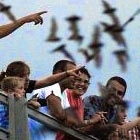



 Imperial Bedroom
Imperial Bedroom Portrait Hall
Portrait Hall Mauve Room
Mauve Room Maple Room
Maple Room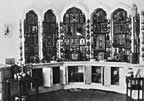 Aleksey's Bedroom
Aleksey's Bedroom Nicholas's Study
Nicholas's Study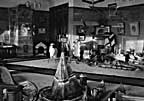 Aleksey's Playroom
Aleksey's Playroom Formal Reception
Formal Reception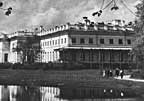 Balcony View
Balcony View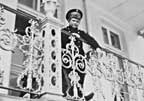 Aleksey- Balcony
Aleksey- Balcony Children-Mauve
Children-Mauve Nicholas's Bathroom
Nicholas's Bathroom Alexandra- Mauve
Alexandra- Mauve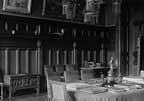 Nicholas's Reception
Nicholas's Reception Tsarskoe Selo Map
Tsarskoe Selo Map